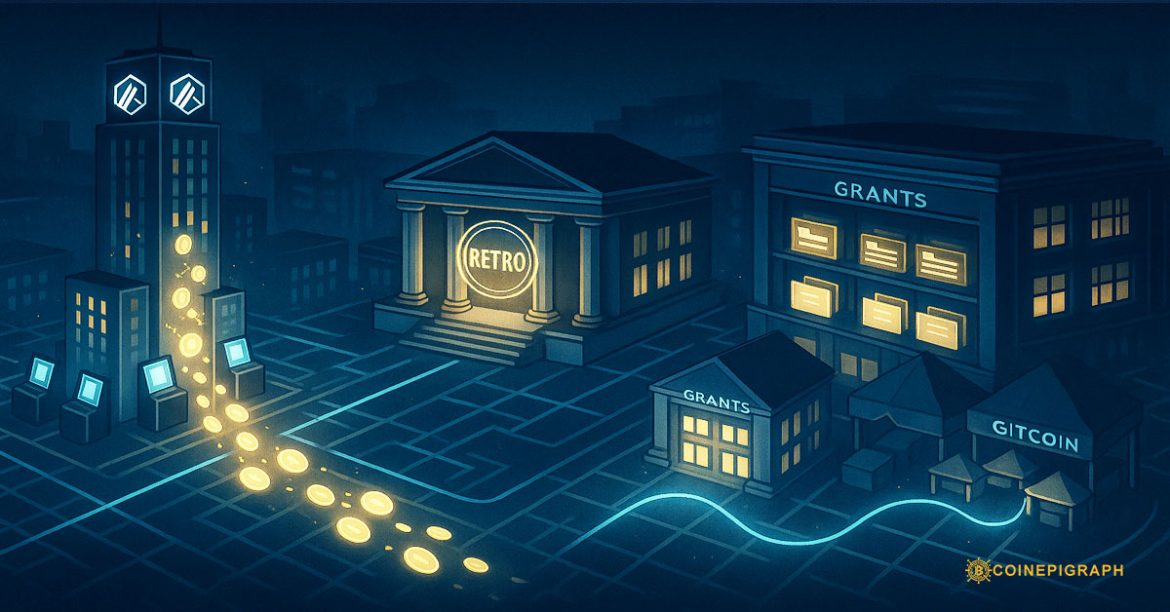CoinEpigraph Editorial Desk | October 12, 2025
TL;DR
DAO treasuries are a real capital market. Public dashboards show $20B+ in liquid assets across major DAOs, with the long tail pushing higher. Flagship programs—Arbitrum’s STIP/LTIP/AGV, Optimism’s Retro Funding, Uniswap Foundation grants, and Gitcoin rounds—now distribute amounts that rival mid-tier venture funds on an annual basis, but with on-chain transparency, programmatic criteria, and faster feedback loops. The constraint isn’t money—it’s governance design, reporting, and execution.
The new allocators-in-chief
- How big is this market? DeepDAO tracks $20B–$25B in DAO treasury assets (liquid + vesting/protocol funds), concentrated among a few large organizations.
- Who’s writing checks?
- Arbitrum DAO: Multiple programs: STIP (50M ARB), backfunds/bridges, LTIP (35M ARB), and a Gaming Ventures allocation of up to 200M ARB approved in 2024.
- Optimism Collective: Retro Funding distributed 20.4M OP across 2024 and continued piloting in 2025 (Season 7 showed millions more in awards).
- Uniswap Foundation: Disbursed $9.9M in FY’24; $7.0M YTD disbursed and $18.9M committed by Q2’25.
- Gitcoin: Ongoing seasonal grants; 2025 rounds continue with seven-figure distributions (e.g., $1.3M in GG23 alone).
Takeaway: At scale, these programs collectively deploy eight- and nine-figure sums per year—with auditable trails and public KPIs.
What “outspend” actually means
We don’t mean DAOs beat the entire VC industry. We mean: within web3, top DAOs’ annual grant + incentive flow is comparable to (and often larger than) the check-writing of many early-stage funds targeting the same builders—especially in infra, public goods, and liquidity-sensitive apps. The distribution engine is programmatic: tokens, milestones, dashboards, and on-chain attestations.
The playbooks (and how they differ)
A) Ecosystem incentives (Arbitrum)
Short-term and long-term programs (STIP/LTIP) rewarded usage and liquidity; newer vertical funds (AGV for gaming, up to 200M ARB) add targeted bets. Expect reporting cadences, claim schedules, and post-mortems on performance.
B) Retroactive public goods (Optimism)
Reward impact after the fact. In 2024, 20.4M OP went to 374 builders; 2025 refines scope and evaluation while continuing awards. This flips grant risk: ship first, then get paid if impact is proven.
C) Programmatic grants (Uniswap Foundation)
Classic grants with deep governance visibility: FY’24 $14.8M committed / $9.9M disbursed; Q1–Q2’25 added $18.9M committed and $7.0M disbursed YTD. Focus areas: research, tooling, ecosystem health.
D) Quadratic & community rounds (Gitcoin)
Matching pools amplify many small donors; 2025 continues multi-mechanism rounds (e.g., GG23 at $1.3M combined disbursement). Useful for early traction and legitimacy.
Founder’s rubric: winning DAO capital (without wasting cycles)
- Map to the mechanism. Need liquidity & user growth? → incentives (STIP-style). Shipping public goods or infra? → Retro Funding / Gitcoin. Protocol R&D or ecosystem lifts? → Foundation grants. (Yes, combine them—sequence matters.)
- Quantify impact ex-ante. Define KPIs you don’t control (organic usage, retention, costs per active) to avoid vanity targets.
- Telemetry first. Publish a live metrics page before funding hits. Review weekly; post public debriefs.
- Milestone vesting + cliffs. Ask for tranches tied to leading indicators (activation, intent conversion) and trailing quality (retention).
- Design exit ramps. Document how incentives turn off. DAOs pay for outcomes, not eternal drip.
DAO treasurer’s checklist: spend like a sovereign wealth fund
- Diversity & duration: Avoid native-token monoculture. Ladder stables/ETH, consider short-duration funds when policy allows. (Arbitrum’s ongoing diversification debates are instructive.)
- Program mix: Balance retro (impact-proven) vs. prospective (experiments).
- Vendor & oracle independence: Two RP Cs, two oracles, two custody paths.
- Public accounting: Quarterly dashboards with commitments vs. disbursements vs. outcomes.
- Capital recycling: Clawbacks and revshare for programs that monetize.
The risks (markets still underpricing)
- Native-token reflexivity. Many treasuries are still dominated by their own token; price drawdowns compress runway and skew incentives. (Uniswap/Arbitrum examples show the paradox.)
- Administration drag. Treasury ops can become costly and slow; several DAOs openly track overhead vs. yield/impact.
- Grant heat without product-market fit. Incentives can paint over weak retention; insist on post-incentive cohorts.
- Regulatory perimeters. Stablecoin/ETP clarity in the EU vs. U.S. enforcement means venue choices affect custody and redemption ops. Read related article: MiCA vs. SEC — Diverging Futures for Global Compliance
What to watch (next 12 months)
- Bigger vertical funds (gaming, AI agents, real-world assets) governed by DAOs.
- Milestone-oracle markets: standardized attestations powering automatic releases/clawbacks.
- Cross-DAO co-funding: Uniswap × Arbitrum-style joint programs (playbooks already exist).
- Public goods “indexing”: recurring retro pools tied to shared infra usage (RPC, clients, ZK libraries).
👉 “The CoinEpigraph Bottom Line”
DAOs aren’t side quests; they’re allocators. With billions in treasury assets and disciplined programs, they now outspend much of the early-stage market inside crypto—and they do it with on-chain evidence. If you build, learn the mechanisms and publish your telemetry. If you govern, diversify and enforce outcomes. The capital is here; the craft is how it moves.
At Coinepigraph, we pride ourselves on delivering cryptocurrency news with the utmost journalistic integrity and professionalism. Our dedicated team is committed to providing accurate, insightful, and unbiased reporting to keep you informed in the ever-evolving crypto landscape. Stay tuned as we expand our coverage to include new sections and thought-provoking op-eds, ensuring Coinepigraph remains your trusted source for all things crypto. -Ian Mayzberg Editor-in-Chief
The team at CoinEpigraph.com is committed to independent analysis and a clear view of the evolving digital asset order.
To help sustain our work and editorial independence, we would appreciate your support of any amount of Bitcoin/Satoshi to this address below: 3NM7AAdxxaJ7jUhZ2nyfgcheWkrquvCzRm
and through our Support Page.
🔍 Disclaimer: CoinEpigraph is for entertainment and information, not investment advice. Markets are volatile — always conduct your own research.




